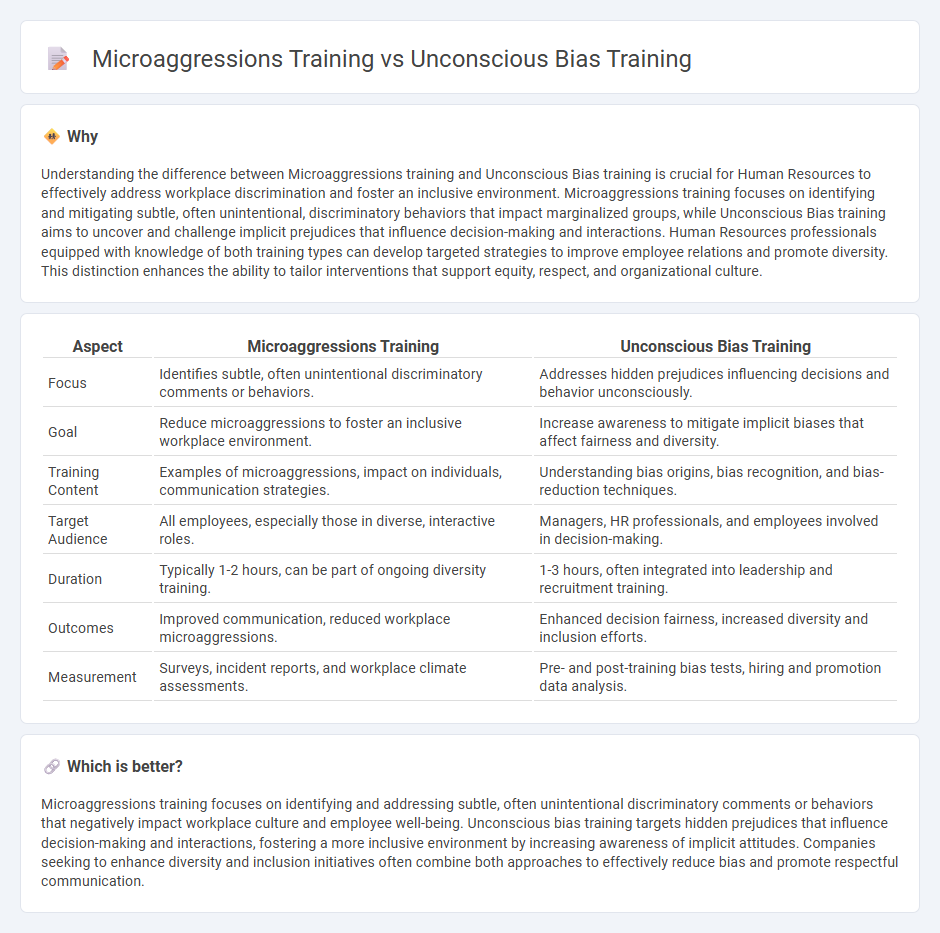
Microaggressions training focuses on identifying and addressing subtle, often unintentional, discriminatory comments or actions that marginalize individuals based on race, gender, or other identities, fostering a more inclusive workplace. Unconscious bias training aims to reveal and mitigate hidden prejudices that influence decisions and behaviors unknowingly, improving fairness in hiring, promotions, and daily interactions. Explore further to understand which training best suits your organization's diversity and inclusion goals.
Why it is important
Understanding the difference between Microaggressions training and Unconscious Bias training is crucial for Human Resources to effectively address workplace discrimination and foster an inclusive environment. Microaggressions training focuses on identifying and mitigating subtle, often unintentional, discriminatory behaviors that impact marginalized groups, while Unconscious Bias training aims to uncover and challenge implicit prejudices that influence decision-making and interactions. Human Resources professionals equipped with knowledge of both training types can develop targeted strategies to improve employee relations and promote diversity. This distinction enhances the ability to tailor interventions that support equity, respect, and organizational culture.
Comparison Table
| Aspect | Microaggressions Training | Unconscious Bias Training |
|---|---|---|
| Focus | Identifies subtle, often unintentional discriminatory comments or behaviors. | Addresses hidden prejudices influencing decisions and behavior unconsciously. |
| Goal | Reduce microaggressions to foster an inclusive workplace environment. | Increase awareness to mitigate implicit biases that affect fairness and diversity. |
| Training Content | Examples of microaggressions, impact on individuals, communication strategies. | Understanding bias origins, bias recognition, and bias-reduction techniques. |
| Target Audience | All employees, especially those in diverse, interactive roles. | Managers, HR professionals, and employees involved in decision-making. |
| Duration | Typically 1-2 hours, can be part of ongoing diversity training. | 1-3 hours, often integrated into leadership and recruitment training. |
| Outcomes | Improved communication, reduced workplace microaggressions. | Enhanced decision fairness, increased diversity and inclusion efforts. |
| Measurement | Surveys, incident reports, and workplace climate assessments. | Pre- and post-training bias tests, hiring and promotion data analysis. |
Which is better?
Microaggressions training focuses on identifying and addressing subtle, often unintentional discriminatory comments or behaviors that negatively impact workplace culture and employee well-being. Unconscious bias training targets hidden prejudices that influence decision-making and interactions, fostering a more inclusive environment by increasing awareness of implicit attitudes. Companies seeking to enhance diversity and inclusion initiatives often combine both approaches to effectively reduce bias and promote respectful communication.
Connection
Microaggressions training and unconscious bias training are interconnected in addressing the subtle, often unintentional behaviors that perpetuate workplace discrimination. Both trainings focus on increasing awareness of implicit attitudes and patterns that affect decision-making, communication, and inclusion in human resources practices. By understanding unconscious biases, employees and managers are better equipped to recognize and mitigate microaggressions, fostering a more equitable and respectful work environment.
Key Terms
**Unconscious Bias Training:**
Unconscious bias training targets implicit prejudices that influence decision-making and behavior without conscious awareness, improving workplace diversity and inclusion. This training employs evidence-based techniques such as introspective exercises and scenario analyses to help individuals recognize and mitigate their automatic biases. Discover more about how unconscious bias training can transform organizational culture and promote equity.
Implicit Association
Unconscious bias training targets implicit associations by helping individuals recognize and mitigate automatic, often unconscious prejudices that influence behavior and decision-making. Microaggressions training emphasizes identifying and addressing subtle, often unintentional discriminatory comments or actions rooted in these implicit biases. Explore deeper insights into how implicit associations shape workplace culture and equitable practices.
Stereotype Awareness
Unconscious bias training concentrates on recognizing and addressing implicit stereotypes that influence behavior and decision-making without conscious awareness. Microaggressions training emphasizes identifying and mitigating subtle, often unintentional, discriminatory remarks or actions that reinforce negative stereotypes. Explore detailed strategies and impacts of both training types to enhance stereotype awareness effectively.
Source and External Links
Implicit bias training - Wikipedia - Unconscious bias training programs aim to help individuals recognize their implicit biases, typically using tools like the Implicit-Association Test, with ongoing debate about their long-term effectiveness in reducing bias.
Unconscious Bias Training That Works - Harvard Business Review - This training raises awareness of automatic, often race- or gender-based judgments that influence workplace behavior, seeking to foster more equitable hiring, promotion, and daily interactions.
Visible difference and unconscious bias training - Changing Faces - Unconscious bias training helps teams identify and challenge assumptions based on appearance, background, or identity, promoting a more inclusive and fair workplace culture.
 dowidth.com
dowidth.com